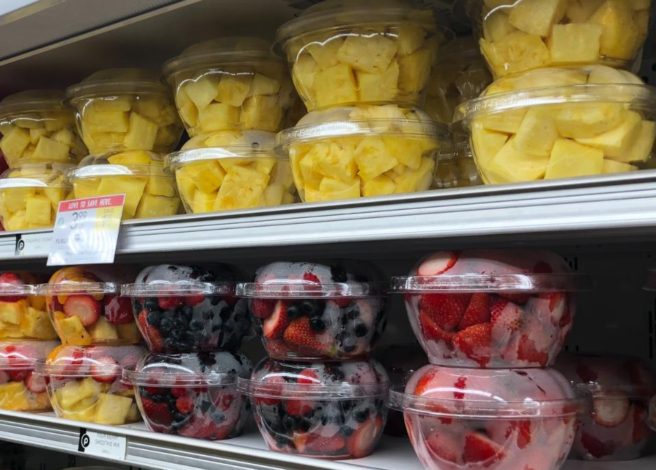Every day, millions of dollars in fresh produce travels through the supply chain. The success of this process relies greatly on how well the packaging performs. Testing produce packaging means knowing how the materials interact with the food inside.
Unlike other food products, fresh produce continues breathing, ripening, and changing after harvest, making it particularly challenging to package and preserve. Food industry pros must know how to test and evaluate produce packaging. This skill can greatly affect their profits. After all, knowledge is power.
This week we caught up with Jeff Brandenburg, a veteran in the packaging industry with 45 years of experience and President of The Qfresh Lab/JSB Group. Brandenburg, who holds degrees in Chemical and Biomedical Engineering and Food Safety, shares his insights as both a respected academic instructor and international consultant specializing in fresh food packaging technology.
This article shares practical ways to test produce packaging. You’ll learn simple checks you can do at the store and advanced methods used in labs. We’ll cover how produce behaves in packaging, what to look for during testing, and how to maintain quality longer. These insights will help you make better packaging decisions and reduce waste — and let’s not forget, keep your margins thriving.
Understanding the Living Nature of Packaged Produce
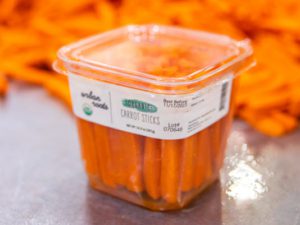
It’s alive! (No, not Frankenstein’s monster.) When you package fresh produce, you’re packaging something that’s living and breathing. Produce has a “respiration rate.” This measures how much oxygen it takes in and how much carbon dioxide it releases. It works similarly to how humans breathe. Along with this breathing process, produce also gives off moisture and heat. Different types of produce breathe in their own way. Leafy greens, like spinach, breathe heavily. In contrast, root vegetables breathe much more slowly.
This breathing process makes produce packaging unique.
Unlike packaging chips or crackers, you’re creating an environment for living matter. The package needs to let the right amount of air in and out while keeping the produce fresh.
Cut produce needs even more careful packaging than whole produce. When you slice into fruits or vegetables, they respond like any living thing would to an injury — their breathing speeds up. This is called a wound response. Think of it like how a person’s breathing gets faster after an injury. The prepared produce releases more moisture and heat, and the exposed areas can start to leak juices.
This is why processed produce doesn’t last as long and needs better packaging. For example, a whole tomato can sit on your counter, but once you slice it, it needs to be packaged and refrigerated immediately unless you’re a fan of mold (we know you’re not!).
The Life Cycle of Packaged Produce
The journey starts when packaging happens. Now, the produce begins to engage with its environment in the container. The product starts using oxygen and making carbon dioxide. This process creates a passive modified atmosphere inside the package. It typically takes 2-3 days to reach optimal gas levels, during which time proper gas exchange becomes crucial.
The best environment needs oxygen levels under 10% and CO₂ levels between 10-15%. It also requires a steady temperature and the right moisture levels to avoid dehydration and condensation.
No matter what you do, produce will start to go bad over time. You’ll notice several signs: the colors might fade, or yellow, leaves will start to wilt, fuzzy mold might appear, strange smells can develop, the texture gets mushy, and moisture either dries up or leaks out.
Watching for these signs helps you figure out how long your produce will last in its packaging.
Steps for Shelf Life Testing
Shelf life testing can be done in different ways. It depends on what resources and facilities you have. Here’s how different industry segments can effectively monitor and test product shelf life:
Advanced Testing
 Research labs and big processing centers use unique tools to analyze how well packaging works. They can measure oxygen and CO₂ levels in packages. They also analyze moisture content and conduct microbiological tests to ensure food safety. Think of it as giving produce a complete physical exam, minus the awkward paper gown.
Research labs and big processing centers use unique tools to analyze how well packaging works. They can measure oxygen and CO₂ levels in packages. They also analyze moisture content and conduct microbiological tests to ensure food safety. Think of it as giving produce a complete physical exam, minus the awkward paper gown.
These facilities control testing environments. They keep fresh-cut produce at 41.5°F/5°C or colder. Conditions that packages encounter in the real world are recreated, including changes in temperature during transport and shifts in altitude during shipping. They evaluate taste, smell, and texture to see how produce quality changes, which gives them important data on shelf life performance.
Practical Testing for Retailers and Smaller Processors
Retailers and processors can still test shelf life without fancy equipment. They just need to observe things closely and keep good records. Here’s a practical approach:
Temperature Monitoring: Store products at standard refrigeration temperature. Check and log readings daily. Monitor fluctuations during door openings and closings. Document any maintenance or unusual events that might affect cooling performance.
Visual Assessment Protocol: Create a standardized checklist for daily visual inspection that includes product color, texture, and signs of dehydration or decay. For example, with leafy greens, note any yellowing, wilting, or browning of edges. For sliced produce, watch for moisture accumulation or drying at cut surfaces. Take dated photos when possible to track changes over time. 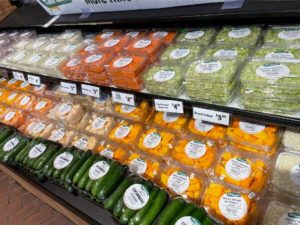
Quality Evaluation: Set up a daily sampling schedule where staff evaluates product quality. This should include examining produce for:
- Texture changes (crispness, firmness)
- Visible moisture loss or excess moisture in packaging
- Color changes
- Odor development
- Package integrity and appearance
Record Keeping: Maintain detailed records that track:
- Delivery dates and initial product condition
- Daily temperature logs
- Visual inspection results
- Customer feedback and returns
- Date when the product becomes unsaleable
- Storage location and display conditions
Real-World Testing: Test products under actual store conditions rather than ideal scenarios. This includes:
- Regular rotation through different display cases
- Exposure to typical lighting conditions
- Normal handling during restocking
- Standard operating hours and temperature patterns
Basic Testing for Small Retailers 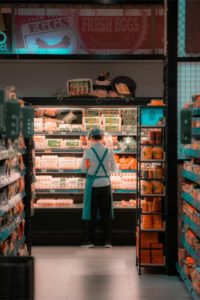
Even the smallest retailers can implement an effective shelf-life monitoring program:
- Mark received cases with arrival dates and track how long products maintained acceptable quality
- Keep a simple log of products that don’t sell through before quality deteriorates
- Note seasonal variations in product quality and shelf life
- Document customer feedback about product freshness
- Monitor and record cooler temperatures consistently
- Establish clear criteria for when to remove products from sale
Real-world testing means accepting that your produce isn’t chilling in a climate-controlled paradise. It must handle the busy store displays, the daily ups and downs, and the rough handling from shelf to cart. Remember, the seasons change. Summer strawberries face unique challenges that winter strawberries do not.
Critical Tips for Success
Understanding produce-specific characteristics is essential for effective shelf-life testing. Different types of produce have varying respiration rates, ethylene production levels, and sensitivities. This knowledge helps prevent compatibility issues when packaging mixed products.
Temperature control remains the most common point of failure in produce packaging. Problems can arise from inconsistent refrigeration, delayed cooling after harvest, temperature abuse during loading and unloading, or inadequate cold chain monitoring. A comprehensive temperature management strategy must address each of these potential failure points.
Packaging mismatches frequently lead to shortened shelf life. This can happen when packaging isn’t made for specific produce respiration rates. It may also be due to incorrect barrier properties, poor seal integrity, or incorrect perforation patterns. Some produce, such as broccoli and onions, emit higher levels of CO₂ and need packaging that can allow for a higher transmission rate. Proper micro perforations will allow the CO₂ to leave the package, preventing bulging and food spoilage.
When mixing different types of produce, plan for those items with higher respiration rates to have shorter shelf lives. For example, suppose you’re combining fresh-cut arugula (high respiration, needs plenty of oxygen) with carrots (lower respiration, requires less oxygen). In that case, you’ll need to consider the packaging for the arugula’s needs. Better yet, keep those faster-breathing, quicker-to-spoil items to no more than 10% of any mixed package. This way, if they start to decline, they won’t take down the whole package with them. In short, while carrots and arugula can be buddies in a salad, doesn’t mean they would make great roommates in a package.
Are You Ready to Test for Shelf Life?
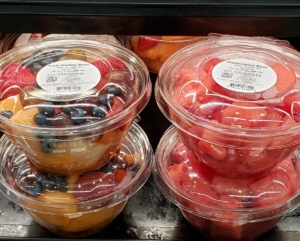 Testing produce packaging starts with understanding that produce is alive and breathing. Whether you have a high-tech lab or check produce in your store, consistency in testing is crucial. Good record-keeping also matters a lot. Different fruits and vegetables “breathe” at different rates. So, match your packaging to each product’s needs. Maintain steady temperatures and select compatible produce for packaging. This approach keeps your products fresher for a longer time and helps minimize waste.
Testing produce packaging starts with understanding that produce is alive and breathing. Whether you have a high-tech lab or check produce in your store, consistency in testing is crucial. Good record-keeping also matters a lot. Different fruits and vegetables “breathe” at different rates. So, match your packaging to each product’s needs. Maintain steady temperatures and select compatible produce for packaging. This approach keeps your products fresher for a longer time and helps minimize waste.
Inline Plastics is committed to finding what works best for you, even when that path leads elsewhere. Don’t hesitate to contact us with any questions along the way.
Interested in learning more about The QFresh Lab /JSB Group, LLC? Visit their website or contact them directly.

